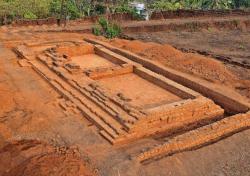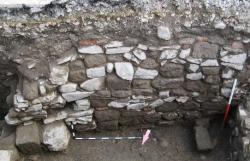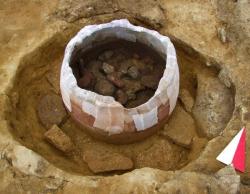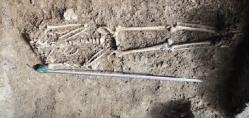INSTITUT SUPERIEUR D'ANTHROPOLOGIE
INSTITUTE OF ANTHROPOLOGY
ONLINE COURSES / COURS A DISTANCE
SPRING TERM : APRIL 2015
REGISTER NOW
INDE –  Kumbla - Excavations conducted by a team from the Department of Archaeology, University of Kerala, during the last three weeks in the medieval fort at Kumbla have unearthed a large hall, possibly meant for congregation. The excavations are part of the research project ‘A Survey of Forts of Kerala’ jointly funded by the University Grants Commission (UGC) and University of Kerala. The excavation has also yielded large quantity of roof tiles, local pottery, Chinese shards, lead bullets and a mould to manufacture them.The unearthed hall, which had an east-west orientation, had its entrance in the north. The building was exclusively made of dressed lateritic blocks and was plastered internally. The hall was paved with lateritic stones and plastered and had three demarcated divisions caused by low wall rises on the floor, possibly indicating a hierarchical space distribution within the congregational hall, Dr. Ajit Kumar told The Hindu . The roof was supported on large wood beams and lentils and the roof was laid with terracotta tiles. This palace, considering its nature of construction, seems to have its origin in the 17{+t}{+h}-18{+t}{+h}century during the reign period of the Bednur Nayakas. The palace structure did undergo many additions and alteration in subsequent period, to retain its stability and utility, he said. “The Kumbla area was under the hegemony of the Raja of Maypadi Kovilakam who had a jurisdiction extending from Kumbla to Chandragiri River in the south. During the zenith of the Vijayanagara Empire, this area was under their control and later it passed hands to the Nayakas of Bednore, and the local Raja acted as their feudatory. It passed to the hands of the Mysore rulers and subsequent after the defeat of Tipu Sultan by the British, it fell into their hands, Dr. Ajit Kumar explained. The fort is situated 14 km north of Kasaragod and the closest railway station is Kumbla, two km away. The roughly trapezoidal fort can be characterised as a “land fort.” It is situated on a lateritic hillock on the right bank of the Arikady River.
Kumbla - Excavations conducted by a team from the Department of Archaeology, University of Kerala, during the last three weeks in the medieval fort at Kumbla have unearthed a large hall, possibly meant for congregation. The excavations are part of the research project ‘A Survey of Forts of Kerala’ jointly funded by the University Grants Commission (UGC) and University of Kerala. The excavation has also yielded large quantity of roof tiles, local pottery, Chinese shards, lead bullets and a mould to manufacture them.The unearthed hall, which had an east-west orientation, had its entrance in the north. The building was exclusively made of dressed lateritic blocks and was plastered internally. The hall was paved with lateritic stones and plastered and had three demarcated divisions caused by low wall rises on the floor, possibly indicating a hierarchical space distribution within the congregational hall, Dr. Ajit Kumar told The Hindu . The roof was supported on large wood beams and lentils and the roof was laid with terracotta tiles. This palace, considering its nature of construction, seems to have its origin in the 17{+t}{+h}-18{+t}{+h}century during the reign period of the Bednur Nayakas. The palace structure did undergo many additions and alteration in subsequent period, to retain its stability and utility, he said. “The Kumbla area was under the hegemony of the Raja of Maypadi Kovilakam who had a jurisdiction extending from Kumbla to Chandragiri River in the south. During the zenith of the Vijayanagara Empire, this area was under their control and later it passed hands to the Nayakas of Bednore, and the local Raja acted as their feudatory. It passed to the hands of the Mysore rulers and subsequent after the defeat of Tipu Sultan by the British, it fell into their hands, Dr. Ajit Kumar explained. The fort is situated 14 km north of Kasaragod and the closest railway station is Kumbla, two km away. The roughly trapezoidal fort can be characterised as a “land fort.” It is situated on a lateritic hillock on the right bank of the Arikady River.
http://www.thehindu.com/news/cities/Thiruvananthapuram/excavations-at-kumbla-fort-unearth-palace-hall/article7063107.ece
ITALIE –  Mantoue - One of the most delightfully decorated rooms in the history of Renaissance art has reopened at Mantua's Palazzo Ducale three years after quake damage. Mantua suffered when a series of earthquakes in northern Italy in May and June 2012, with severe aftershocks. Restoration of the palazzo itself cost about 750,000 euros, authorities have said. "We are facing one of the masterpieces of the Italian Renaissance," said Franceschini. The Palazzo Ducale complex, built between the 14th and the 17th century mainly by the Gonzaga family, includes some 500 rooms. But among the most famous is the Camera degli Sposi, which was frescoed by Andrea Mantegna between 1465 and 1474 and has been praised for its use of 'trompe l'oeil' details and its seminally foreshortened 'di sotto in su' ('looking up') ceiling. The frescoes depict significant meetings and scenes from the court of Ludovico Gonzaga. The Court Scene on the north wall shows Ludovico Gonzaga, dressed informally, with his wife Barbara of Brandenburg. They are seated with their relatives, while a group of courtiers fill the rest of the wall. The figures are interacting in an 'illusionistically' expanded space. On the west wall is the Meeting Scene. This fresco shows Ludovico in official robes in an ideal meeting with his son, Cardinal Francesco Gonzaga, the Holy Roman Emperor Frederick III and Christian I of Denmark. The ceiling features a playful oculus frescoed with cherubs peering down - apparently through the circular opening to a blue sky above - into the room itself. The palace's superintendent Giovanna Paolozzi Strozzi has said the bridal chamber will be part of a new museum itinerary including the St George castle. As well, visitors can view the collection of Mantuan businessman Romano Freddi who Strozzi said has given the Ducal palace 85 works including a portrait of Francis IV Gonzaga by Rubens. The Gonzaga family lived in the palace from 1328 to 1707, when the dynasty died out.
Mantoue - One of the most delightfully decorated rooms in the history of Renaissance art has reopened at Mantua's Palazzo Ducale three years after quake damage. Mantua suffered when a series of earthquakes in northern Italy in May and June 2012, with severe aftershocks. Restoration of the palazzo itself cost about 750,000 euros, authorities have said. "We are facing one of the masterpieces of the Italian Renaissance," said Franceschini. The Palazzo Ducale complex, built between the 14th and the 17th century mainly by the Gonzaga family, includes some 500 rooms. But among the most famous is the Camera degli Sposi, which was frescoed by Andrea Mantegna between 1465 and 1474 and has been praised for its use of 'trompe l'oeil' details and its seminally foreshortened 'di sotto in su' ('looking up') ceiling. The frescoes depict significant meetings and scenes from the court of Ludovico Gonzaga. The Court Scene on the north wall shows Ludovico Gonzaga, dressed informally, with his wife Barbara of Brandenburg. They are seated with their relatives, while a group of courtiers fill the rest of the wall. The figures are interacting in an 'illusionistically' expanded space. On the west wall is the Meeting Scene. This fresco shows Ludovico in official robes in an ideal meeting with his son, Cardinal Francesco Gonzaga, the Holy Roman Emperor Frederick III and Christian I of Denmark. The ceiling features a playful oculus frescoed with cherubs peering down - apparently through the circular opening to a blue sky above - into the room itself. The palace's superintendent Giovanna Paolozzi Strozzi has said the bridal chamber will be part of a new museum itinerary including the St George castle. As well, visitors can view the collection of Mantuan businessman Romano Freddi who Strozzi said has given the Ducal palace 85 works including a portrait of Francis IV Gonzaga by Rubens. The Gonzaga family lived in the palace from 1328 to 1707, when the dynasty died out.
http://www.ansa.it/english/news/lifestyle/arts/2015/04/02/famed-bridal-chamber-reopens-in-mantua_cb748143-94e1-406a-85af-c79081f33574.html
BULGARIE –  Aquae Calidae - The Ancient Thracian and Roman city of Aquae Calidae, which was known as Thermopolis in medievalByzantium and Bulgaria, has been damaged by a flooding, Burgas Municipality has alarmed. The architectural structures of Aquae Calidae – Thermopolis Archaeological Preserve in Bulgaria’s Burgas, where local archaeologists recently found Byzantine coins and a Roman inscription, have suffered a lot of damage by floods since the start of 2015. “The flooding has made pointless the archaeological excavations so far in which unique Roman, Early Byzantine, and medieval thermae (public baths) have been found,” says Burgas Municipality, adding that the thermae at Aquea Calidae might turn out to be the largest thermae in Bulgaria, a title currently held by the Great Roman Thermae in another Black Sea city, Varna. Burgas Municipality complains that the archaeological excavations of Aquae Calidae – Thermopoliscannot continue until the water is drained from the archaeological site.
Aquae Calidae - The Ancient Thracian and Roman city of Aquae Calidae, which was known as Thermopolis in medievalByzantium and Bulgaria, has been damaged by a flooding, Burgas Municipality has alarmed. The architectural structures of Aquae Calidae – Thermopolis Archaeological Preserve in Bulgaria’s Burgas, where local archaeologists recently found Byzantine coins and a Roman inscription, have suffered a lot of damage by floods since the start of 2015. “The flooding has made pointless the archaeological excavations so far in which unique Roman, Early Byzantine, and medieval thermae (public baths) have been found,” says Burgas Municipality, adding that the thermae at Aquea Calidae might turn out to be the largest thermae in Bulgaria, a title currently held by the Great Roman Thermae in another Black Sea city, Varna. Burgas Municipality complains that the archaeological excavations of Aquae Calidae – Thermopoliscannot continue until the water is drained from the archaeological site.
http://archaeologyinbulgaria.com/2015/04/03/flooding-damages-aquae-calidae-thermopolis-archaeological-preserve-in-bulgarias-burgas-hinders-excavations/
INDE –  Sivasagar - For the first time in the northeast, a Ground Penetrating Radar (GPR) survey is being undertaken at two archaeological sites of the state to detect the presence of any hidden structure/ floor/ tunnel underneath. The survey began on March 29. The Guwahati circle of the Archaeological Survey of India, in collaboration with IIT-Kanpur, began the GPR survey at Talatal Ghar and Kareng Ghar (Ahom royal palaces) located in Sivasagar district. The survey will continue till April 4 and the results will be processed in a few months. Myths associated with the two palaces claim the existence of secret structures, baffling archaeologists and experts for decades.
Sivasagar - For the first time in the northeast, a Ground Penetrating Radar (GPR) survey is being undertaken at two archaeological sites of the state to detect the presence of any hidden structure/ floor/ tunnel underneath. The survey began on March 29. The Guwahati circle of the Archaeological Survey of India, in collaboration with IIT-Kanpur, began the GPR survey at Talatal Ghar and Kareng Ghar (Ahom royal palaces) located in Sivasagar district. The survey will continue till April 4 and the results will be processed in a few months. Myths associated with the two palaces claim the existence of secret structures, baffling archaeologists and experts for decades.
http://timesofindia.indiatimes.com/city/guwahati/What-lies-beneath-ASI-inspects-Ahom-palaces/articleshow/46767482.cms
USA –  Rimrock Draw - A bright orange agate rock was found that has a sharp cutting edge with bovine blood on it, which could have been used as multiple tools 15,800 years ago. “It could be one of the oldest artifacts in America,” archaeologist Patrick O’Grady said. O’Grady lead the group which found the item. The rock was found by an archaeological field school put on by the museum during the summer of 2012, and has recently garnished media attention as tests are being done on the item. The artifact was found at the Rimrock Draw site in central Oregon, ten feet below the earth’s surface, according to O’Grady. The estimation for the rock’s age is based on the layer of ash it was found under, which was caused by Mount St. Helens’ eruption 15,400 years ago. “It’s an old, old site, and this one find may push back date,” said Tom Connolly, the archaeological research director at the UO Museum of Natural and Cultural History. The agate is unlike any of the rock nearby and and was found 18 inches below the layer of ash along with obsidian flakes, predating the eruption of Mount St. Helens by quite some time. The law of superposition states that the oldest items are found at the bottom, which helps to relatively date the age of objects such as fossils. It’s possible the artifact could have been moved underneath the ash due to an animal disturbance or landslide. Research is still underway to determine the proper age of the stone tool. Researchers are now digging around the area where the item was found to see if they can locate any other objects and to determine if the layer of ash is just in a particular pocket or spread out and covering a large area.
Rimrock Draw - A bright orange agate rock was found that has a sharp cutting edge with bovine blood on it, which could have been used as multiple tools 15,800 years ago. “It could be one of the oldest artifacts in America,” archaeologist Patrick O’Grady said. O’Grady lead the group which found the item. The rock was found by an archaeological field school put on by the museum during the summer of 2012, and has recently garnished media attention as tests are being done on the item. The artifact was found at the Rimrock Draw site in central Oregon, ten feet below the earth’s surface, according to O’Grady. The estimation for the rock’s age is based on the layer of ash it was found under, which was caused by Mount St. Helens’ eruption 15,400 years ago. “It’s an old, old site, and this one find may push back date,” said Tom Connolly, the archaeological research director at the UO Museum of Natural and Cultural History. The agate is unlike any of the rock nearby and and was found 18 inches below the layer of ash along with obsidian flakes, predating the eruption of Mount St. Helens by quite some time. The law of superposition states that the oldest items are found at the bottom, which helps to relatively date the age of objects such as fossils. It’s possible the artifact could have been moved underneath the ash due to an animal disturbance or landslide. Research is still underway to determine the proper age of the stone tool. Researchers are now digging around the area where the item was found to see if they can locate any other objects and to determine if the layer of ash is just in a particular pocket or spread out and covering a large area.
http://www.dailyemerald.com/2015/03/31/15000-year-old-stone-tool-found/
ITALIE –  Volterra - Archaeologists investigating a potential building site near Volterra discovered a grave dating from pre-Etruscan times, the Tuscan city announced on Thursday. The grave, consisting of a large jar which is an estimated one meter in height and more than 80 cm in diameter, was found during survey archaeological investigations for the building of a nursery school. The jar was in good condition, and was found in a ditch with a stone slab covering the lid. It was taken to the Tuscany archaeological superintendency's conservation laboratory.
Volterra - Archaeologists investigating a potential building site near Volterra discovered a grave dating from pre-Etruscan times, the Tuscan city announced on Thursday. The grave, consisting of a large jar which is an estimated one meter in height and more than 80 cm in diameter, was found during survey archaeological investigations for the building of a nursery school. The jar was in good condition, and was found in a ditch with a stone slab covering the lid. It was taken to the Tuscany archaeological superintendency's conservation laboratory.
http://www.ansa.it/english/news/lifestyle/arts/2015/04/02/pre-etruscan-tomb-discovery_e9c36c20-58a7-4bcd-a17f-0e58b3464079.html
CHINE –  Qihe caves - A set of human skeletal remains dating back to the Shang and Zhou Dynasties was found on March 25, 2015 at an archaeological site at the Qihe caves being excavated by the Fujian Museum and the Zhangping Culture and Recreation Bureau. Researchers also discovered a number of pottery shards from the Neolithic period, copper ornaments and burial objects made of tortoise plastron beneath the remains.
Qihe caves - A set of human skeletal remains dating back to the Shang and Zhou Dynasties was found on March 25, 2015 at an archaeological site at the Qihe caves being excavated by the Fujian Museum and the Zhangping Culture and Recreation Bureau. Researchers also discovered a number of pottery shards from the Neolithic period, copper ornaments and burial objects made of tortoise plastron beneath the remains.
http://www.china.org.cn/china/2015-04/01/content_35211694.htm